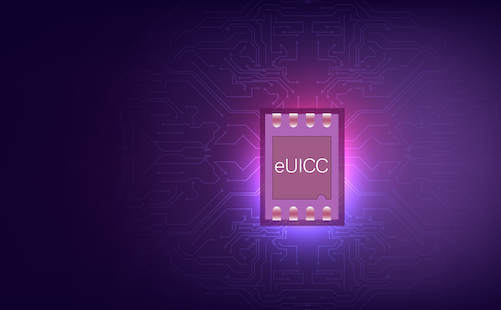

Digging deeper into eSIM: how do expectations meet reality?
The eSIM has been coined the next generation of the SIM card. Its uses are vast and varied, and optimism is high that it will be a driving force in enabling the expansion of IoT.
The revolutionary potential of eSIM is not, however, without its challenges. The question of how revolutionary eSIM is could depend largely on how effectively the benefits can be realised against the backdrop of network providers wanting to preserve profits and device manufacturers embracing the technology.
So - just how does the reality of eSIM adoption match its potential? Is it really going to change society, or is that ambition just a fantasy?
What exactly is eSIM?
eSIM is essentially a service that stores mobile subscription and encryption information on a chip (the eUICC). The term eUICC is sometimes used interchangeably with eSIM or M2M, but the latter is more often used to describe the hardware component.
A Machine-to-Machine (M2M) SIM, as its name suggests, is a SIM that allows connected machines to communicate. It is a SIM form factor, just like the micro-SIM and nano-SIM. However, in contrast to these well-known SIM form factors, M2M SIMs are designed to withstand harsh conditions that our regular phone cards are not made for.
eSIM is short for ‘embedded Subscriber Identity Module’ or 'embedded SIM'. The SIM is an application that runs on a UICC and is responsible for authenticating users on a mobile network. A UICC houses a SIM application and, among other things, also allows for secure access via your mobile data plan to payment systems or media servers.
Contrary to its name, an embedded SIM is not necessarily literally embedded onto the card and it can come in all form factors.
Just how quickly is eSIM really catching on?
Among the main use cases for eSIM are IoT devices and enterprise mobile networks. Particularly in the case of IoT, eSIM is being hailed as one of the biggest enablers for device manufacturers to create efficient global supply chains and improve the end-user experience. For enterprises and businesses, eSIM enables management and security to be centralised and offers flexibility to network users and managers.
However, despite showing a lot of promise, the rate of adoption of eSIM is slower than expected, according to a report by Vodafone for the Body of European Regulators for Electronic Communications in 2017. The report highlights the fact that, in 2017, around 20 million IoT devices that were added to cellular networks globally had embedded UICCs. During that time there were over 200 million non-eUICC additions, which puts eUICC’s market share at less than 10%.
The share of the market that eSIM has is expected to grow to 30% in 2021 and to nearly 50% in 2024. The cost of deploying eSIM and lack of interoperability across SIM vendors are thought to be the main causes for the slower-than-expected adoption so far.
Is eSIM being over-hyped?
Not at all; there are plenty of positive real-life use cases of eSIM. The automotive industry has embraced eSIM in the production of connected vehicles, a move that has provided benefits for motorists including faster recovery times in the event of a breakdown, the ability to anticipate traffic conditions and signal changes allowing for greater fuel efficiency, which benefits the environment and the user’s wallet, and enhanced safety thanks to seamless communication between vehicles on the road.
Another example of the successful use of eSIMs can be found in the utility market. Smart meters are becoming increasingly popular in the consumer market due to the convenience and control that they offer, not to mention the potential cash savings. Rolling out and maintaining these devices has been made much simpler due to eSIM and OTA provisioning.
The fact that a visit to the customer’s home is not required to set up the device and that some problems can be diagnosed and fixed remotely saves businesses time and money.
The fact is though, eSIM is not a one-size-fits-all solution. While it may be a huge enabler for smart device manufacturers, it may not be such a game-changer in the enterprise and consumer mobile markets, at least for the time being.
What is holding eSIM back?
Businesses looking to embrace eSIM need to consider the commercial implications of adopting the technology across their network. The flexibility will come at a cost. Traditionally, in the B2B and B2C mobile marketplaces, upfront device costs are spread out over the term of the contract which can vary between 12 and 36 months.
The service provider has guaranteed business for the contract term and so spreading the cost of devices is easy. With an eSIM contract service providers may be reluctant to spread device costs and so businesses may be faced with a hefty up-front fee. Whether that fee is worth the flexibility and other benefits afforded by eSIM will be a crucial question that may determine the long-term viability of eSIM for businesses.
From a technology point of view, how flexible eSIM truly very much depends on whether OTA migrations can happen in practice. For this to be the case, both the outgoing and incoming SIM vendors must be able to exchange the subscriber’s data seamlessly and quickly.
This means a link must be established between all the major providers or an independent third-party organisation must manage the process. Fortunately, the GSMA has established a framework that many of the major mobile operators around the world have agreed to. The full white paper from March of last year is available to read the white paper here.
What does the future of eSIM look like?
Vodafone’s projections may turn out to be fairly accurate, but it is much harder to predict exactly which markets will be responsible for this growth. Apple and Samsung have started to offer embedded SIMs in their latest devices, and it is likely that other manufacturers will follow suit, but so far eSIM in consumer devices has not enabled much other than allowing users to utilise dual SIMs.
Connected and IoT devices present a much greater opportunity for eSIM and could well end up informing some of the decisions that still lay ahead of network providers in terms of how much flexibility they will allow end-users to have.
Interested in learning more about Velos IoT eSIM solution? Contact one of our IoT experts for more details
Speak to a Velos IoT expert
Related articles


Consumer eSIM vs M2M eSIM: What are the Differences
With the latest GSMA specifications paving the way for remote SIM provisioning, eSIM, also known as...


